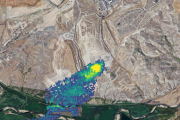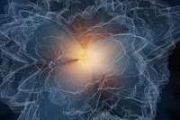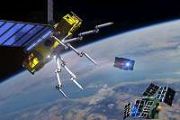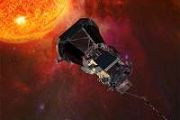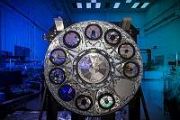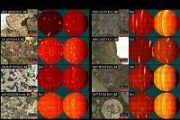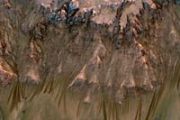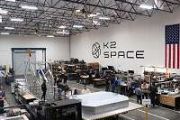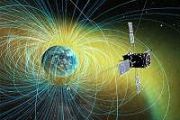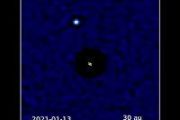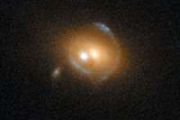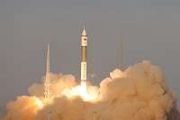
Copernical Team
Chinese astronauts return to Earth with fruitful experimental results
 The Shenzhou XVI crew consisting of three Chinese astronauts returned to Earth safely on Tuesday, after completing a five-month space station mission.
Shenzhou XVI's return capsule, carrying astronauts Jing Haipeng, Zhu Yangzhu and Gui Haichao, touched down at the Dongfeng landing site in North China's Inner Mongolia autonomous region at 8:11 am (Beijing Time), and the crew had all left th
The Shenzhou XVI crew consisting of three Chinese astronauts returned to Earth safely on Tuesday, after completing a five-month space station mission.
Shenzhou XVI's return capsule, carrying astronauts Jing Haipeng, Zhu Yangzhu and Gui Haichao, touched down at the Dongfeng landing site in North China's Inner Mongolia autonomous region at 8:11 am (Beijing Time), and the crew had all left th Why the Roman Space Telescope will study the flickering lights of the Milky Way
 NASA's Nancy Grace Roman Space Telescope will provide one of the deepest-ever views into the heart of our Milky Way galaxy. The mission will monitor hundreds of millions of stars in search of tell-tale flickers that betray the presence of planets, distant stars, small icy objects that haunt the outskirts of our solar system, isolated black holes, and more. Roman will likely set a new record for
NASA's Nancy Grace Roman Space Telescope will provide one of the deepest-ever views into the heart of our Milky Way galaxy. The mission will monitor hundreds of millions of stars in search of tell-tale flickers that betray the presence of planets, distant stars, small icy objects that haunt the outskirts of our solar system, isolated black holes, and more. Roman will likely set a new record for Physicists embark on six-year hunt for dark matter particle
 In the pitch dark of the cosmos lurks an invisible kind of matter. Its presence is seen in the rippling ebb and flow of galaxies, but it's never been directly observed. What secrets lie beneath the surface, brewing in the deep?
Physicists have long theorized about the composition of dark matter, which is thought to be five times more abundant than regular matter. Among competing hypotheses
In the pitch dark of the cosmos lurks an invisible kind of matter. Its presence is seen in the rippling ebb and flow of galaxies, but it's never been directly observed. What secrets lie beneath the surface, brewing in the deep?
Physicists have long theorized about the composition of dark matter, which is thought to be five times more abundant than regular matter. Among competing hypotheses New jet stream discovered in Jupiter's upper atmosphere
 High-speed jet streams are a common feature in the atmospheres of many planets. On the Earth, jet streams form at various latitudes and meander around the planet, changing latitude and reaching speeds approaching 400 km/h at an altitude of over 10 km above the surface. On the giant planets Jupiter and Saturn, jet streams are one of the main features of the atmosphere; they are perfectly aligned
High-speed jet streams are a common feature in the atmospheres of many planets. On the Earth, jet streams form at various latitudes and meander around the planet, changing latitude and reaching speeds approaching 400 km/h at an altitude of over 10 km above the surface. On the giant planets Jupiter and Saturn, jet streams are one of the main features of the atmosphere; they are perfectly aligned Scientists discover molten layer covering Martian core
 NASA's InSight mission to Mars helped scientists map out Mars' internal structure, including the size and composition of its core, and provided general hints about its tumultuous formation.
But findings from a new paper published in the journal Nature could lead to reanalysis of that data. An international team of researchers discovered the presence of a molten silicate layer overlying Mar
NASA's InSight mission to Mars helped scientists map out Mars' internal structure, including the size and composition of its core, and provided general hints about its tumultuous formation.
But findings from a new paper published in the journal Nature could lead to reanalysis of that data. An international team of researchers discovered the presence of a molten silicate layer overlying Mar Daily Minor Planet volunteers spot an asteroid passing close to Earth
 Volunteers working with The Daily Minor Planet have made the project's first big discovery: an asteroid passing very near planet Earth. On the night of October 3rd, a telescope for the Catalina Sky Survey snapped four pictures of a far northern section of the sky. The next day, volunteers H. N. DiRuscio, X. Liao, V. Gonano and E. Chaghafi spotted a clear streak moving through each image and quic
Volunteers working with The Daily Minor Planet have made the project's first big discovery: an asteroid passing very near planet Earth. On the night of October 3rd, a telescope for the Catalina Sky Survey snapped four pictures of a far northern section of the sky. The next day, volunteers H. N. DiRuscio, X. Liao, V. Gonano and E. Chaghafi spotted a clear streak moving through each image and quic MDA acquires SatixFy's Digital Payload Division in $60 Million deal
 In a significant move, SatixFy Communications Ltd. has concluded its $60 million strategic transaction with MacDonald, Dettwiler and Associates Ltd. (MDA), according to a company announcement. Both firms are pivotal players in the satellite communications space, with SatixFy known for its cutting-edge chipsets and MDA as a powerhouse in the provision of technology and services for the ever-growi
In a significant move, SatixFy Communications Ltd. has concluded its $60 million strategic transaction with MacDonald, Dettwiler and Associates Ltd. (MDA), according to a company announcement. Both firms are pivotal players in the satellite communications space, with SatixFy known for its cutting-edge chipsets and MDA as a powerhouse in the provision of technology and services for the ever-growi InSPA collaborates with multi-sector partners to fast-track space commercialization
 Aiming to bring commercial manufacturing in space closer to reality, NASA's Inter-Agency Space Platform for Advanced (InSPA) portfolio is rallying support from diverse sectors. NASA is engaging with professionals from industry, academia, and other government agencies to help fine-tune its InSPA objectives, share expertise, and increase the chances of commercial success in space.
These coll
Aiming to bring commercial manufacturing in space closer to reality, NASA's Inter-Agency Space Platform for Advanced (InSPA) portfolio is rallying support from diverse sectors. NASA is engaging with professionals from industry, academia, and other government agencies to help fine-tune its InSPA objectives, share expertise, and increase the chances of commercial success in space.
These coll AI-enhanced LizzieSat satellite by Sidus Space clears crucial environmental tests
 Sidus Space, listed on the NASDAQ as SIDU, has reached a key juncture in its satellite development timeline. The company recently concluded environmental testing on its LizzieSat satellite bus, setting the stage for a launch slated for the first quarter of 2024. This satellite is notably enhanced with artificial intelligence capabilities, which are expected to give it a leading edge in its opera
Sidus Space, listed on the NASDAQ as SIDU, has reached a key juncture in its satellite development timeline. The company recently concluded environmental testing on its LizzieSat satellite bus, setting the stage for a launch slated for the first quarter of 2024. This satellite is notably enhanced with artificial intelligence capabilities, which are expected to give it a leading edge in its opera CGI pilots integrated satellite and terrestrial networks for seamless broadband on trains
 In an ambitious initiative to modernize and improve the United Kingdom's rail network, technology solutions firm CGI, satellite operator Eutelsat OneWeb, and connectivity solutions provider Icomera are conducting live trials of a hybrid satellite and terrestrial communication network. The effort is part of the Satellites for Digitalisation of Railways (SODOR) project, supported by the European S
In an ambitious initiative to modernize and improve the United Kingdom's rail network, technology solutions firm CGI, satellite operator Eutelsat OneWeb, and connectivity solutions provider Icomera are conducting live trials of a hybrid satellite and terrestrial communication network. The effort is part of the Satellites for Digitalisation of Railways (SODOR) project, supported by the European S 









